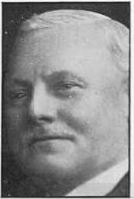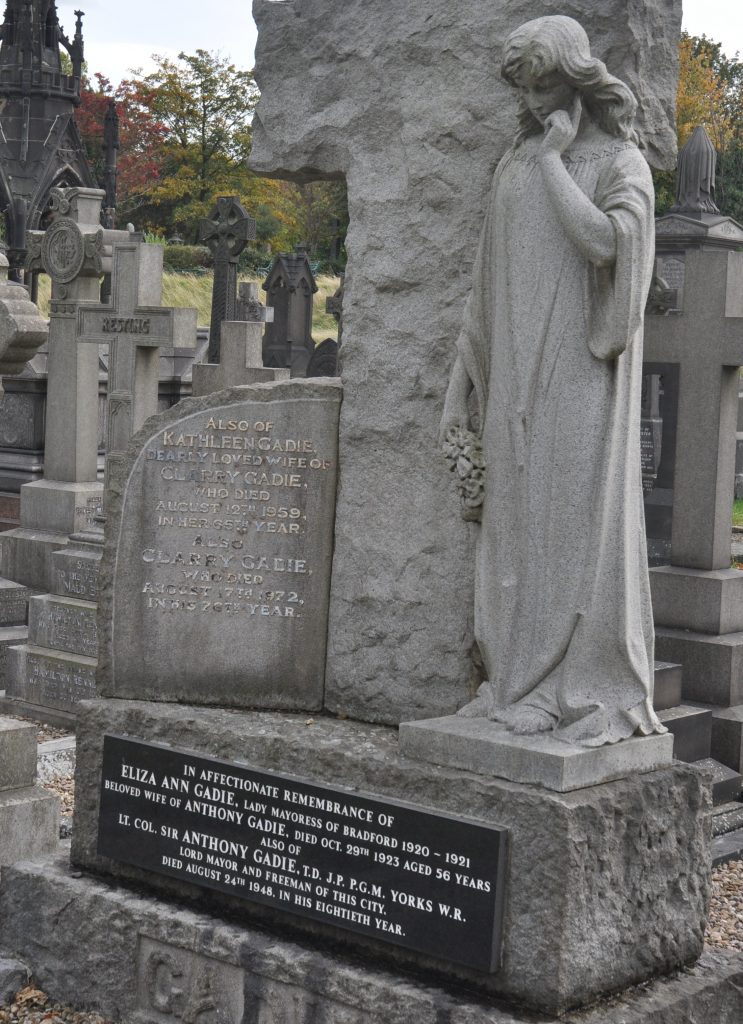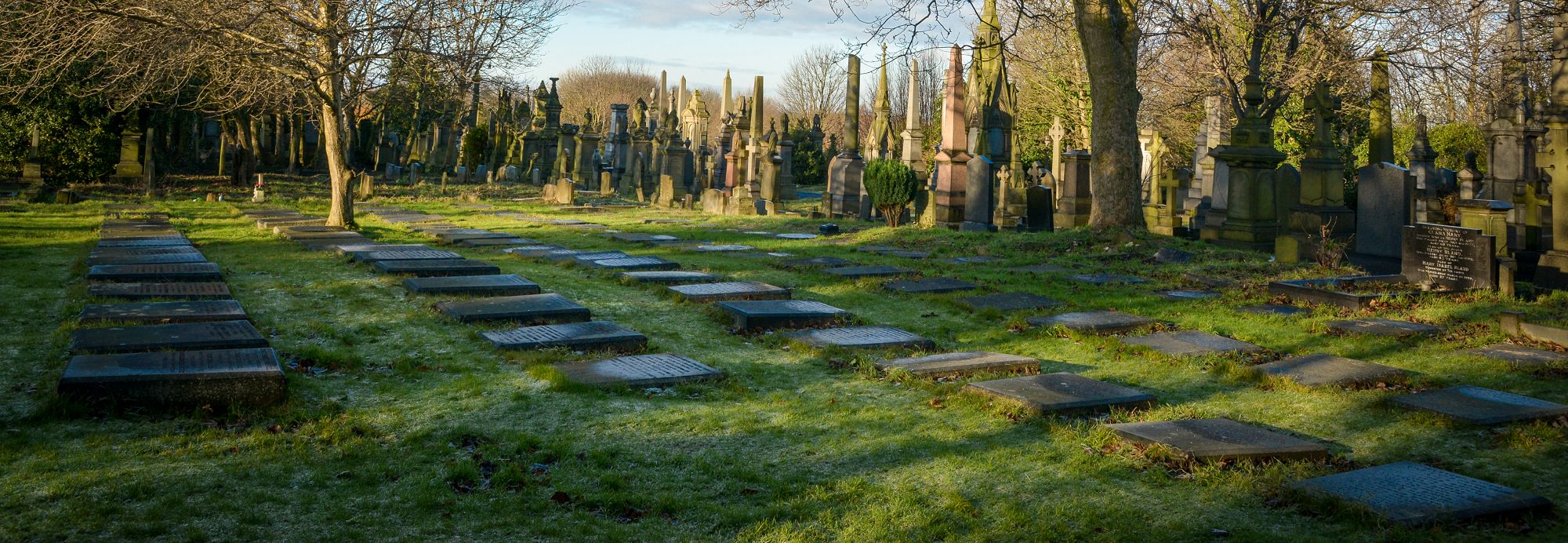Anthony Gadie
Lt. Col. Sir Anthony Gadie T.D. J.P. P.G.M. Yorks W.R.
Lord Mayor and Freeman of the City.
Anthony Gadie was born on 7th September 1868 in Skipton, he was the son of Thomas Martinmas Gadie and Esther Raistrick. His father worked on the railways, in 1861 as a railway porter, and in 1871 as a railway pointsman. They lived at Bank Cottage, Cross Street, Skipton, not too far from the station.

Despite some accounts saying the family moved to Bradford shortly after Anthony was born it is more likely they moved sometime between 1871 when they appeared in the Skipton Census and 1874 when his sister Sarah Elizabeth was born in Bradford. Thomas Gadie joined the Bradford police and became a police constable which got his into all sorts of confrontations with the public. It seems that people didn’t have much respect for the police in those days and he was constantly being attacked. In one incident he lost a tooth when he was attacked by three men. One of his attackers was sentenced to two months at Wakefield House of Correction with hard labour. In other incidents the police including Thomas were stoned by crowds of people.
Anthony was educated at Bradford Parish Church School, and worked as a ‘half timer’ before he reached the age of eleven. He continued his studies at evening classes held at Bradford Church House. In the 1881 census he is shown as a scholar, and in 1891 a clerk. He was employed for 14 years as an invoice clerk and later as a secretary at the Bradford Brick and Tile Company. This may have brought him into contact with many builders and seeing an opportunity he started his own business as a builder and contractor.
He married his cousin Eliza Ann Gadie on 17th April 1895 and they had two sons and two daughters. These were Clarence, Edgar, Doris and Freda. By the turn of the century he had become involved with the Council.
Meanwhile his uncle and father in law, John Bentley Gadie, had started a grocery business in Linguard Street, which is just off the lower reaches of Bolton Road. Unfortunately there was a terrible accident on 14th Jan 1899 when John died after falling from the upper floor of a local Leeds road tram. The 1901 census shows us that Anthony’s father was now registered at 53, Linguard Street and his occupation grocer/shopkeeper, so he must have stepped down from the police and taken over John’s business. At this point he was 61 years of age. By 1911 he was still going strong and had been married 44 years, he was living off a police pension. The census reveals to us that they had brought eleven children in to the world, and that only four were still surviving, one of which was Anthony. Anthony’s parents went on to celebrate their golden wedding anniversary, which must have been quite unusual for a couple born and brought up in Victorian times. Thomas died in 1933 and Esther in March 1924.
Military Career.
An enthusiastic volunteer since 1886, in 1903 through to 12th July 1905 he was Quartermaster and Hon. Lieutenant in the British Army, Royal Garrison Artillery 2nd West Riding Brigade. From July through to 15th Dec 1907 he was Hon Captain and from 8th Dec 1910 Captain. On the 29th of August 1914 he was promoted from Captain to Major, and on 3rd April 1915 to temporary Lieutenant Colonel, until finally on the 22nd July 1917 to Lieutenant Colonel. He was serving with the Royal Artillary, 2nd West Riding Brigade. He went to the front commanding a group of howitzers at the battle of Arras and was mentioned in dispatches. After the war he returned to civilian life and set up business as an auctioneer, operating as A Gadie and Son. One of the properties he was involved with was the sale of the Milner Field estate.
In 1920 he became Mayor of Bradford serving from 1920 to 1921. He was also head of the Conservative and Unionist group.
In October 1923 Anthony’s wife had fallen desperately ill and she was in need of a blood transfusion. Anthony and their son Edgar along with two friends Mr and Mrs Dornan offered to give blood. Mrs Dornan’s was the most suitable but unfortunately this was not sufficient to save her life and she died on 29th October 1923.
In 1924 he was elected MP for Central Bradford and served until 1929
The Nidd Valley Scheme
Bradford’s population had grown incredibly during the Victorian Era and by 1900 it had reached 300,000. With a need to supply Bradford, but also surrounding areas, the water supply system had to maintain supplies to in excess of 450,000 people, plus the requirements of industry. There was a need for the council’s waterworks department to seek out new sources of supply and the Nidd Valley Scheme was launched in 1891 with a view to bring water from the upper reaches of the Nidd into Bradford. This was a huge challenge and it brought out the very best of the Engineers at the time. The result was a masterpiece of engineering. James Watson took charge of the Engineering. Under the scheme two reservoirs were planned, a compensation reservoir at Gouthwaite, and a storage reservoir at Angram. To connect the reservoirs to the treatment works at Chellow Dean in Bradford an aqueduct was built consisting of a pipeline and tunnel. Because of the difference in heights the water could be supplied by gravity and no pumping would be required. To cross the valleys an ingenious syphon system was built.
Gouthwaite reservoir was the first to be built. Work commenced in 1893 and was completed in 1901. Angram followed and was completed in 1915. During the construction of Angram a visit was arranged to the site for dignitaries from other towns that the scheme was intended to supply. Gadie gave a presentation which explained the need for a third reservoir, this time at Scar House, which was just downstream of Angram. It would increase the storage total capacity of the Nidd Valley Scheme to 3.3 billion gallons. This being made up of 1.1 from Angram and 2.2 from Scar House. Without Scar House and the reinforcement of the aqueduct, ie increasing its capacity, the corporation would not have been able to meet demand at peak times and in times of drought.
Anthony was Chair of the waterworks committee when work began on the Scar House reservoir and Lewis Mitchell was the Waterworks Engineer. Anthony carried out the ceremonial duties of cutting the first sod on 5th October 1921 and on completion in 1936 he performed the ‘topping out’ ceremony. Being Chair also made him the Squire of Angram and Scar House.
A temporary village was built at Scar house to house the navvies. Huts were taken from the Raikes Wood Camp at Skipton. The village also had a school, church, cinema and shops. In 1923 two hundred new navvies were recruited to add to the five hundred and seventy who were already being employed. This was a huge operation. Ironically some of the navvies wrote to Anthony during the construction of Angram complaining about the quality of the water and to James Harrison during the construction of Scar House about the quality of the beer.
A Hydro electric scheme was devised by Lewis Mitchell ,the Engineer, and designed and constructed by Vickers Ltd of Sheffield. This was to supply electricity to the village and to power the ropeways, cranes, crushers and other machines required for the construction. Anthony Gadie switched on the power in December 1921.
The 2.1 million pound Scar House reservoir was at the time the largest stone built reservoir in Europe and it was one of the six biggest dams in the World. The walls being 154ft high and 135 ft thick at the base.
To get men and materials to the site at Scar House The Nidd Valley Light Railway was used. It was actually built between 1904 and 1907 for use during the construction of Angram and to provide a passenger service from Pateley Bridge to Lofthouse. Although the scheme was initiated by a Power and Traction Company they couldn’t raise the funds to build it so it was taken over by the Bradford Corporation in 1904, making the corporation the only one in England to run its own railway. The first two locos were named after Alderman Holdsworth and Alderman Milner, Chair and Deputy Chair of the Nidd Valley Light Railway. Sometime later a 0-6-0T Barclay and Sons loco was named Gadie. In fact two separate locos were named Gadie the second being a 0-4-0 . The name plate may have been transferred from the first loco to the second.
For a time the railway offered a passenger service, but after completion of the reservoirs it was shut down, but there are still signs today as to where it had been. The equipment including the rolling stock was sold off in June 1937. The fate of the locos ‘Gadie’ is unknown.
For his political and public service in Bradford, Anthony Gadie was knighted by King George V at Buckingham Palace on the 10th July 1935.
Gadie was initiated into the Shakespeare Lodge No. 1018 Bradford in 1904 and occupied the chair in 1915. He received the rank of S.W. in the province in 1921, and was made Deputy Grand Sword Bearer in Grand Lodge in 1928, subsequently receiving the rank of Junior Deacon in 1934. He was made Assistant Provisional Grand Master in 1932 and Deputy Provisional Grand Master in 1939. Finally he accepted the offer to succeed The Earl of Harewood as Provisional Grand Master of Yorkshire (W.R.) as well as Grand Superintendent of the Royal Arch.
In 1939, now aged 71, he was appointed A.R.P. controller for Bradford and in April 1941 he issued instructions that all paid personnel in the A.R.P. service must carry their respirators on and off duty. He also requested that all volunteers carry their respirators, as an example to the general public.
Anthony Gadie was made Alderman and J.P and in 1944 was given Freedom of the City of Bradford.Lt Col. Sir Anthony Gadie died on 24h August 1948, 1100 mourners attended the funeral service at Bradford Cathedral. Sir Anthony is buried at Undercliffe Cemetery with Eliza Ann Gadie. Also named at the grave site are Clarry (Clarence) Gadie and his wife Kathleen Hardy, together with Edgar Gadie and his wife Lillian Smith.

You can find Sir Anthony Gadie’s monument using the what3words App and website. Follow this link and select satellite view. Click Here. If you are using the App on your phone type in spot.basis.lung in the search box.
Research by Steve Lightfoot

